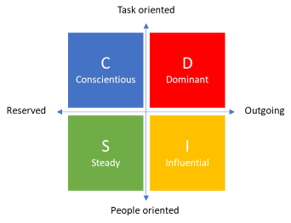If you are new to the idea of Team Praxis, please read our introduction to the concept before using the table below to improve your communications with team members, stakeholders and anyone else involved in your project, programme or portfolio.
 The goals of stakeholder management are to:
The goals of stakeholder management are to:
- ensure that the views and attitudes of all stakeholders are understood;
- influence stakeholders to be supportive of the work wherever possible;
- maximise the impact of supportive stakeholders;
- minimise the impact of unsupportive stakeholders.
When implementing these goals people with different character traits would perceive stakeholder management plans and techniques in different ways.
 Concientious behaviour would typically propose or want to see: Concientious behaviour would typically propose or want to see:
-
a clear explanation of what stakeholder management is aiming to achieve; -
a consistent and systematic approach to identifying, assessing and engaging with stakeholders; -
a focus on objective information about stakeholders so that a considered approach can be identified; -
consideration of lessons learned from previous projects and how they can be applied; -
sufficient objective information to allow informed decisions to be made with adequate time to make these decisions; -
conservative projections as to what influence can be achieved; -
a focus on engaging with detractors rather than supporters to understand why they hold this position. Someone exhibiting concientious behaviour would typically be perceived as: -
engaging with the minimum number of stakeholders, typically in a limited manner; -
cautious in engaging with stakeholders until there has been adequate assessment and consideration of the objectives of engagement; -
supportive of methodical and proven techniques to assess and engage stakeholders. |  Dominant behaviour would typically propose or want to see: Dominant behaviour would typically propose or want to see:
-
action taken quickly to engage with stakeholders to maximise opportunity; -
assessment of stakeholders and the value from engagement done in a dispassionate way; -
a tangible and ideally quantitative approach -
evidence of the benefit of stakeholder engagement activities; -
a concise and efficient process for engaging with stakeholders; -
that they have maximum freedom to take action as they believe necessary; -
the minimum amount of assessment necessary to allow decisions to be made and actions agreed; -
a focus on those with high influence and power; -
timely monitoring and control to ensure that people are held to account for engaging with and influencing stakeholders. Someone exhibiting dominant behaviour would typically be perceived as: -
comfortable with engaging stakeholders but in a limited and formal fashion; -
taking a direct approach to engaging with stakeholders; -
dismissive of what they may perceive as unnecessary process; -
dismissive of stakeholder behaviours that they perceive as hindering action and results. |
 Steady behaviour would typically propose or want to see: Steady behaviour would typically propose or want to see:
-
key individuals engaged in the process and given the opportunity to contribute; -
clearly identified roles for managing stakeholders; -
a focus on subjective measures as well as objective in particular the impact of risk on people; -
a cautious approach to engaging and influencing stakeholders; communication with people from previous projects to obtain lessons learned, focusing on the impact on people of the engagement process; -
inclusion of stakeholders that are not necessarily vocal or actively aiming to engage; -
the opportunity to seek additional information regarding individuals to ensure there is a full understanding of their position; -
a high level of contingency in the planned effort for engagement to ensure that stakeholders can be listened to and unforeseen circumstances addressed; -
strong personal relationships being built; -
fair allocation of responsibilities for those involved. Someone exhibiting steady behaviour would typically be perceived as: -
supportive of engaging with stakeholders on a primarily one-to-one basis; -
building deep personal relationships with a small number of people; -
having a low appetite for risk as they are typically cautious in their outlook; -
keen to follow protocols and processes in full where they are defined. |  Influential behaviour would typically propose or want to see: Influential behaviour would typically propose or want to see:
-
a high level of engagement with stakeholders; -
a clear message that stakeholder engagement increases the likelihood of successful delivery; -
a focus on qualitative measures during the assessment; -
identification and inclusion of a broad range of stakeholders in the engagement process; -
identification of short term responsibilities for engaging stakeholders; -
a broad range of stakeholders being identified that can then be pared down through a prioritisation process; -
equal focus on those who oppose as well as support the project; -
the assessment of stakeholders with a minimal level of formality; -
the adoption and use of qualitative techniques for assessing stakeholders; -
a high level of resources and time being committed to the process; -
informal relationships being created with a large number of stakeholders. Someone exhibiting influential behaviour would typically be perceived as: -
enthusiastic about engaging with stakeholders in particular in groups or through workshops; -
applying the minimum level of process and analysis before engaging with stakeholders; engaging with a broad range and number of stakeholders in a personable way; -
building a large network of stakeholders whose opinions can be sought; -
being overly optimistic about the level of influence that can be achieved. |
Thanks to Donnie MacNicol of Team Animation for providing this page.
 The goals of stakeholder management are to:
The goals of stakeholder management are to:
 Concientious behaviour would typically propose or want to see:
Concientious behaviour would typically propose or want to see: Dominant behaviour would typically propose or want to see:
Dominant behaviour would typically propose or want to see: Steady behaviour would typically propose or want to see:
Steady behaviour would typically propose or want to see: Influential behaviour would typically propose or want to see:
Influential behaviour would typically propose or want to see:



